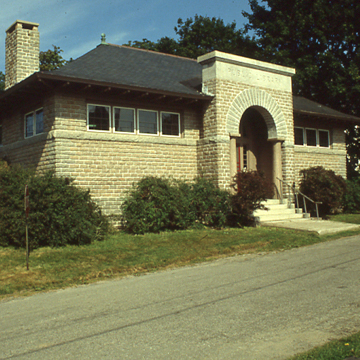Located on Carver Street, a residential block off East Main Street, Vinalhaven Public Library is not only associated with the generosity of steel tycoon Andrew Carnegie, but also with the public library movement as it unfolded in the island community of Vinalhaven. Part of an archipelago in Penobscot Bay, Vinalhaven was an important source of granite in the nineteenth century. The growth of the granite industry in the post–Civil War era and the influx of summer residents in the later nineteenth century spurred a demand for cultural amenities.
The public library movement in Vinalhaven had its beginnings in 1887, when Maine Governor J.R. Bodwell, president of the Bodwell Granite Company (which owned a large quarry on Vinalhaven), pledged to provide space for a book collection, provided there was public support. The town voted to establish a public library, and the women of the existing Vinalhaven Circulating Library contributed 800 volumes in 1890. The new library was installed in the newly dedicated Memorial Hall in 1895. When the town received a $5,200 grant from Andrew Carnegie in 1906, construction began on a new library building.
Using plans drawn by the Boston architectural firm of Clough and Wardner, the Prairie Style library with its handsome, quarry-faced granite edifice was unique among Maine town libraries. Standing on a small, wedge-shaped lot, the library features a symmetrical facade with a centrally located entrance. Rectangular, low, and horizontal in plan, the one-story, hipped-roof building exhibits the hallmark elements of the Prairie Style. A short stairway leads to a landing framed by a round arch supported by polished granite columns set in antis. Sleek granite voussoirs give the arch an impressive quality. Above the arch, a dressed stone plaque capped by a molded cornice bears the inscription “Public Library.” The narrow porch contains a paneled door with sidelights and a three-part arched window. Recessed walls of quarry-faced coursed ashlar flank the entrance. The walls have a stringcourse extending around the building that serves as a sill for small, square, six-over-six windows.
The interior floor plan includes a vestibule, with a bracketed circulation desk and librarian’s office beyond it. Large, boxed beams separate this central space from the reading rooms on either side, whose walls are lined with book shelves. On August 15, 2007, exactly 100 years after its opening, the town celebrated the opening of a million-dollar addition to the library, which included the improvement, upgrading, and enlargement of the facility. The structure’s external appearance remains unaltered.
References
Allin, Lawrence C., and Richard W. Judd. “Creating Maine’s Resource Economy, 1783–1861.” In Maine: The Pine Tree State from Prehistory to the Present,edited by Richard W. Judd, Edwin A. Churchill, and Joel W. Eastman. Orono: University of Maine Press, 1995.
Mahoney, Kirk F., “Vinalhaven Public Library,” Knox County, Maine. National Register of Historic Places Inventory–Nomination Form, 1988. National Park Service, U.S. Department of Interior, Washington, D.C.














